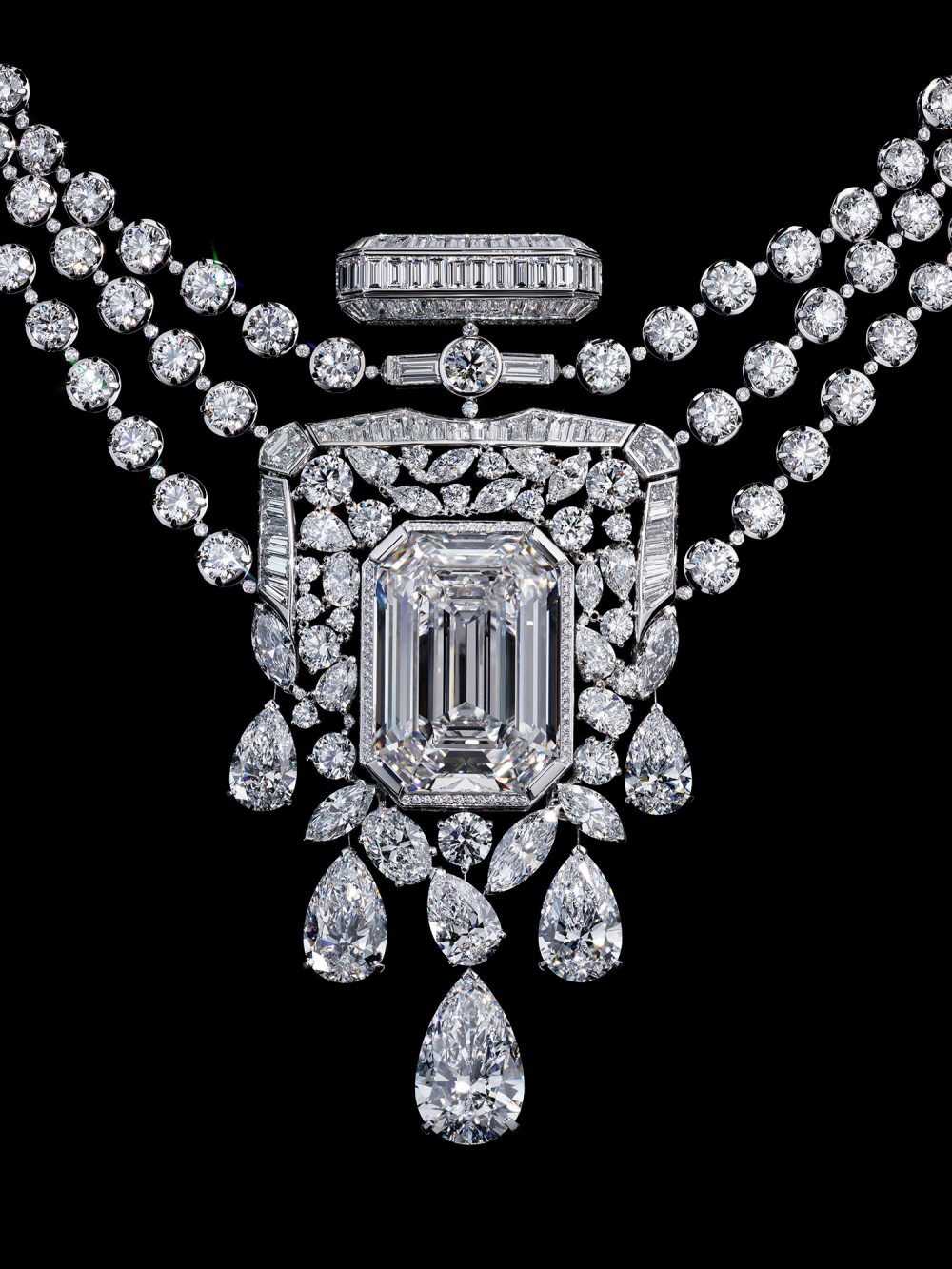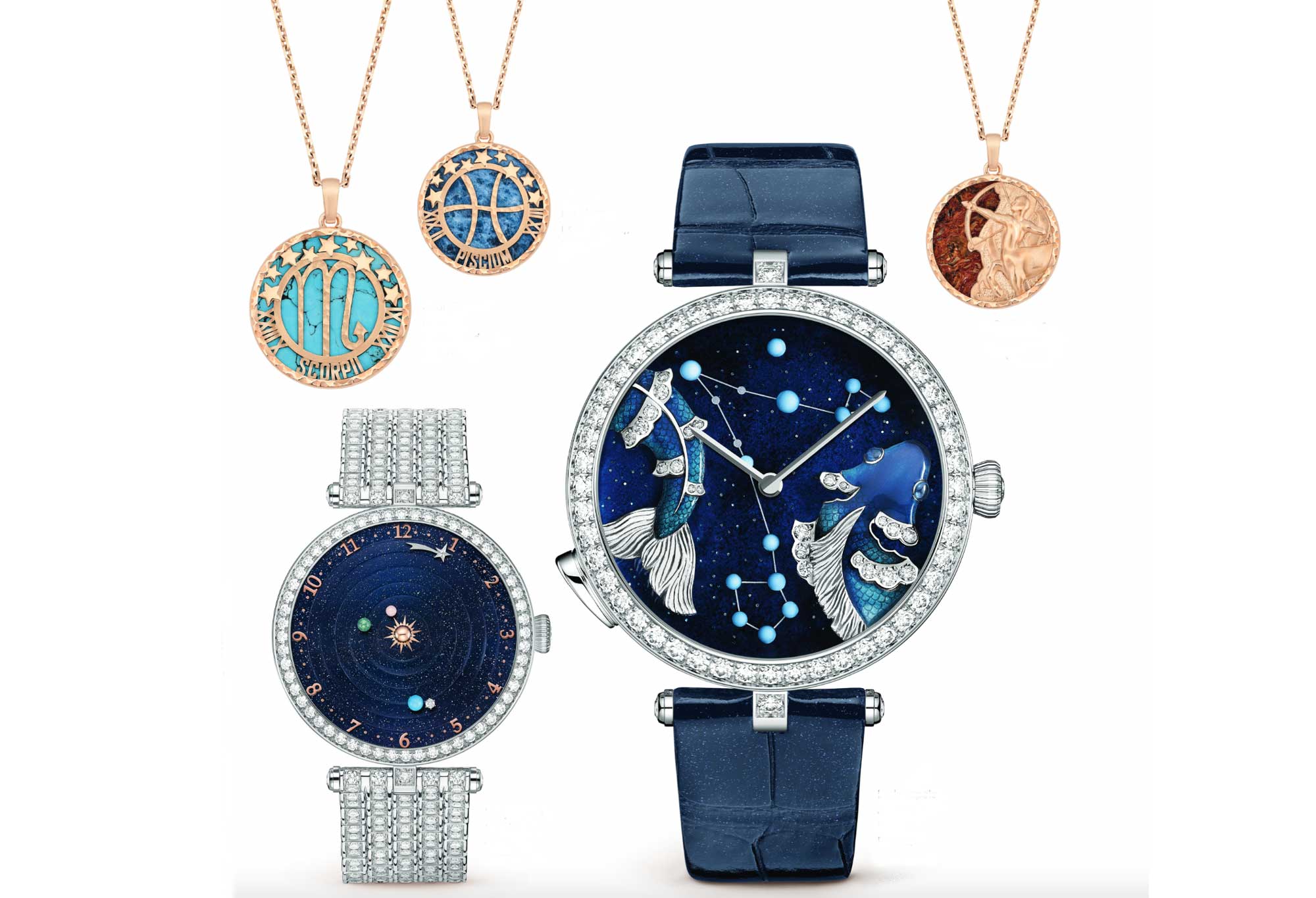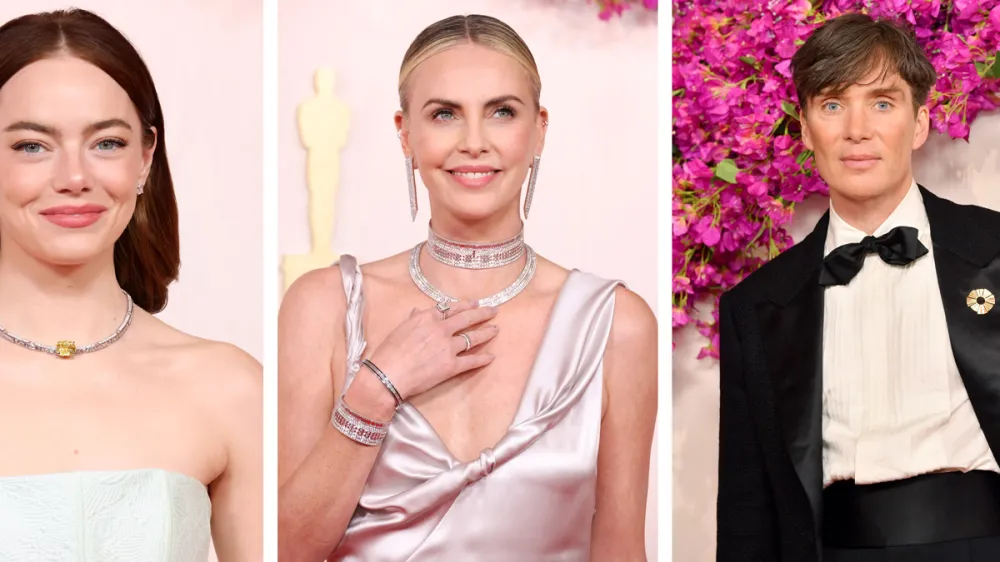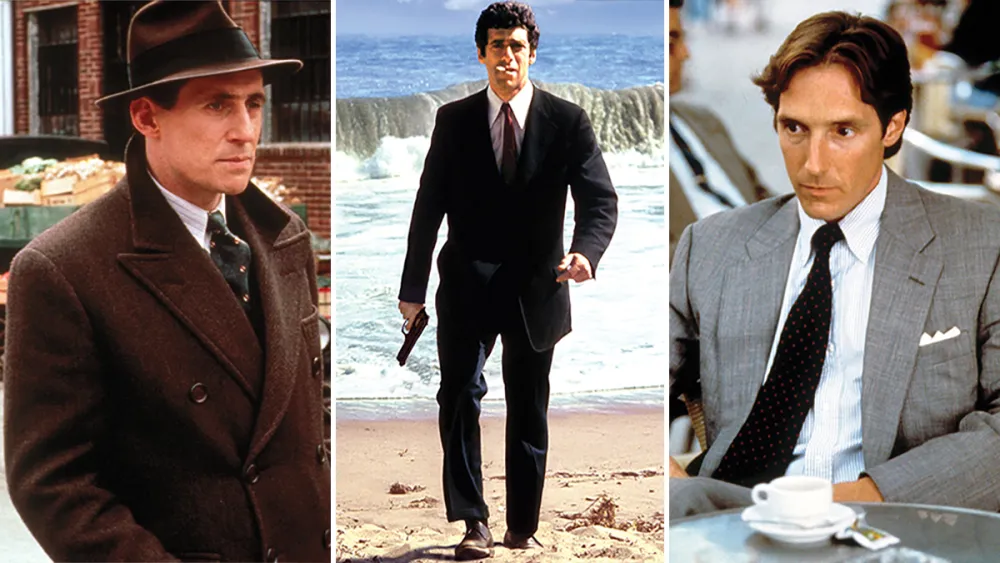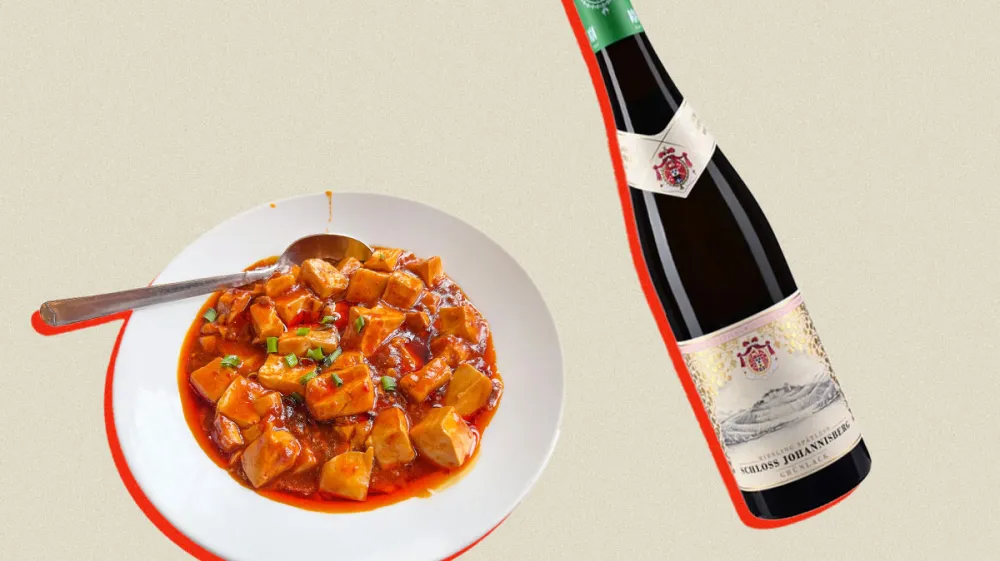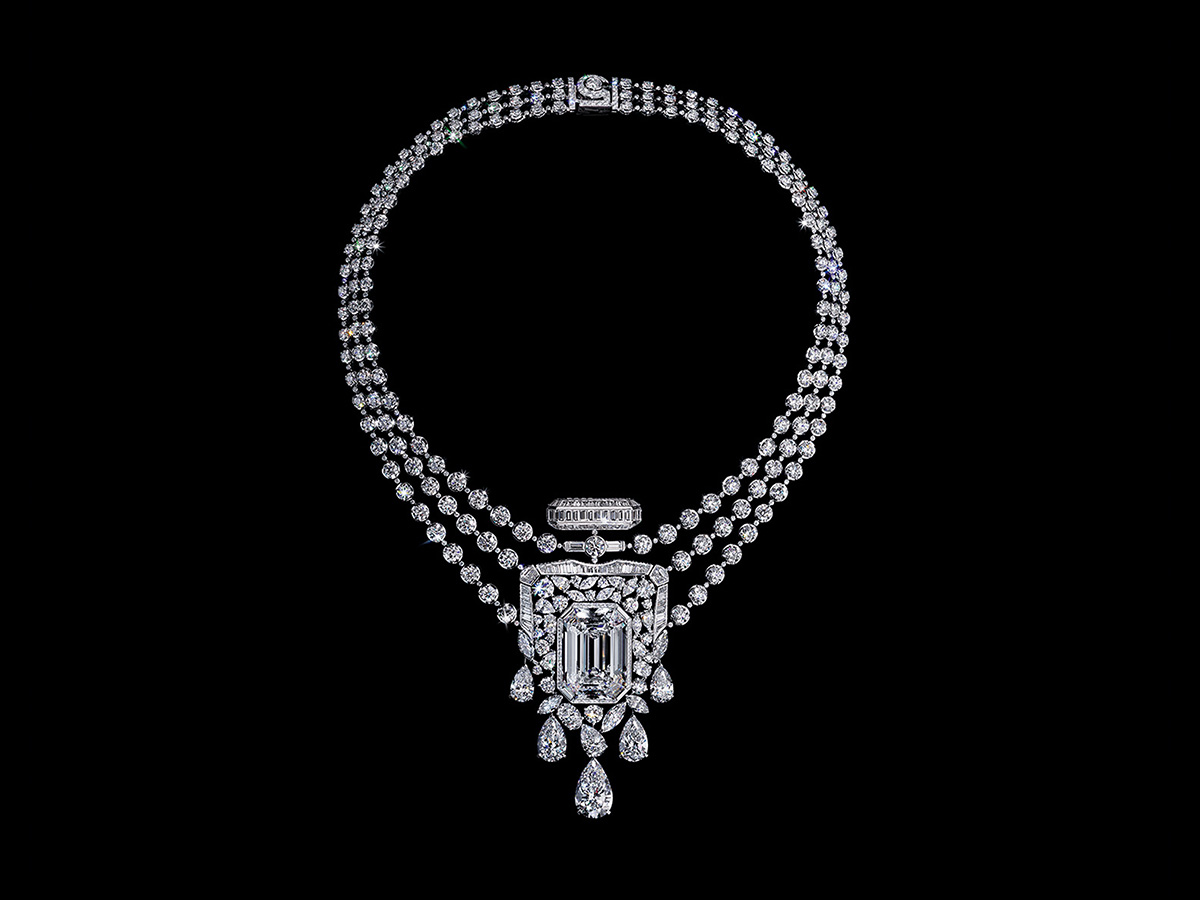
The Art Of Abstraction
Celebrating a centenary this year, N°5 —fashion’s first modern fragrance—marks the milestone with a magnificent high-jewellery.
Related articles
How do you give tangible form to something that is essentially invisible and evocative only through olfactory senses? And a mythic scent, rife with paradoxes, like N°5? Under the lead of Patrice Leguéreau, Chanel’s master of stones, the Chanel jewellery team has been corralled into the pursuit of the improbable—crafting the tangible from a fragrance.
The new 123-piece high-jewellery endeavour, devised for Chanel’s centennial celebrations, sees the prestigious French maison become the first haute joaillerie to create gems inspired by a perfume. It’s Chanel’s largest ever offering of jewels too, as such elevated collections normally only number between 50 and 70 pieces. “The Collection N°5 has an unparalleled scope thanks to the richness of the perfume,” explains Leguéreau. “I didn’t want Collection N°5 to be just a tribute. I conceived it as an immersive experience, a journey into the very soul and story of the N°5 perfume … without being too literal. I wanted to translate its magic and mystery.”
N°5, the grande dame of glamorous fragrances, has been the prevailing gift-to-self through the last century, a symbol for perfume in the same way a diamond announces the expectation of fine jewellery. At the height of her stardom, Marilyn Munroe famously said that a few drops of Chanel N°5 was all she ever wore to bed.
In past collections, the director of Chanel’s Fine Jewellery Creation Studio has absorbed himself among illustrious locations from Gabrielle Chanel’s life (such as Venice’s Gran Canal for Escale à Venise, his January 2021 high-jewellery outing).
Yet this time, aside from exploring Grasse’s fields of jasmine and May roses with house perfumer Olivier Polge, Leguéreau’s inspiration was front and centre on his desk in the French capital: the distinct architecture of the N°5 bottle (an accessory in its own right) and its stopper.
Together with the number five, flowers and the scent’s sillage, the bottle and the stopper are two of five facets that identify Chanel’s iconic perfume—providing the framework for the new jewellery collection.
The challenge to create iridescence from a sensory experience would have no doubt appealed to the company’s audaciously creative founder, Gabrielle “Coco” Chanel, a woman who felt constrained by traditional perfume options when she founded the fashion house in 1910. In her day, perfume spoke to just two distinct female personality types—the respectable woman (pitched anodyne or cloying one-note florals like violet and lily of the valley) and the seductress (potent musks, animalic decadent fragrances).
Gabrielle Chanel, with her couturier’s vantage point, had an eclectic approach to perfume, seeing it as a composition with poetic or expressive possibility. She wanted a more complex and contradictory scent, created for a woman who wore perfume for herself, not others.
The fashion designer’s go-to perfumer in the early part of the 20th century, Ernest Beaux, who would go on to make three more perfumes with her (N°22, Russia Leather, Bois des Îles) was also looking to cut ties with tradition. The Russian-born perfumer was the Tsars’ favourite scent expert, bringing his own modern flair to his profession. His sleight of nose with N°5 was to mix a bouquet of white flower notes with aldehydes, in an unprecedented and canny pairing of nature with synthetics. The crisp, earthy scent was resolutely new guard in 1921—and one of the first perfumes with the ability to linger on the body.
Another creative milestone was reached a decade later in 1932 when Gabrielle Chanel expressed her love affair with diamonds through her first high-jewellery exhibit, Bijoux de Diamants, which eschewed costume pieces in favour of diamonds set in platinum.
This year’s centennial collection therefore stands as a sparkling monument to two of Chanel’s favourite things: diamonds and perfume. Star of the show is the blockbuster 55.55 necklace, composed of 764 diamonds, which captures the bottle’s design principles and its well-known “five”. Other pieces from the collection play on the way that skin is enveloped by perfume.
The entire collection is predicated on comfort and flow, although the cascading powerhouse 55.55—which is destined for the fashion house’s permanent collection, and will be exhibited regionally—has imposing dimensions, and presence. “We wanted to express the fluidity of the perfume in the metal and stonework. We paid particular attention to the suppleness and ergonomics of the jewels so that the gold wraps itself like a cloud of perfume around the neck,” adds Leguéreau.
Chanel’s jewellery craftsmen and women have demonstrated remarkable goldsmithing smarts, alongside exemplary gemstone selection and setting during their 24-month-long tribute to the endurance and complexity of N°5. The central stone having a specific goal weight of 55.55 carats is an unorthodox approach to getting the optimum yield from a piece of rough diamond, but harks back to Gabrielle Chanel’s love of numerology—the number five being a long-held lucky charm that influenced her rituals and choices.
The aim was to custom-cut a perfect octagonal diamond of D Flawless quality, no more or less than that desired weight, over the diamond of greatest dimensions.
The 55.55 necklace, Chanel’s latest riff on the three-strand high-jewellery necklace—a stalwart of its prestigious bi-annual sets—suggests a move from the visible to the invisible with a fringe of pear-shaped diamonds appearing to turn the perfume bottle motif’s base to liquid, as if to flow into the nape in a beautiful dissolve.
Although Gabrielle Chanel only ever designed one high-jewellery collection, her deceptively casual way of handling jewellery in all its moods and expressions is ensconced in the ethos of today’s atelier. Her irreverent enjoyment of diamonds in her 1932 show is an attitude at play in the background of this exceptional birthday year, even though only two pieces of the entirely diamond and platinum collection remain today—the star-shaped Comète brooch and a feather brooch.
From the early 1930s, the founder of the house established the principle that stones needed to fit the design of the jewel, rather than the materials leading the design. Elements of the centenary collection will pay tribute to Chanel’s very first diamonds, particularly with detachable or transformative elements—and collection 55.55’s remembrance speaks to her guiding aesthetics with dazzling potency.
Here, monochrome contrasts, asymmetry, form, line and pattern are preoccupations of Chanel’s jewellery creation, just as they are in its fashion realms under the guidance of creative
director Virginie Viard. The use of crystalline materials, whether white diamonds or rock crystal, evoke the N°5 bottle while underscoring the graphic beauty of the collection’s designs. But colour gets a look in too with amber, citrine and imperial topaz, cut to mimic perfume drops. And in keeping with Leguéreau’s vision, the stones are indeed used to replicate the occurrence of sillage via visual enchantments that lead your eyes across the key points.
The perfumes offered to French women in the early 20th century didn’t please Gabrielle Chanel, so she created her own. And whenever the fashion designer wasn’t pleased with choices offered to her in life, she did the same. In the bejewelled stakes at least, with the Collection N°5 her expectations have been held aloft and magnificently superseded.
This piece comes from the new Winter Issue – on sale now. Get your copy or subscribe here, or stay up to speed on all things with Robb Report’s weekly luxury insights.
Subscribe to the Newsletter
Recommended for you
For Heaven’s Sake
For its latest collection, the jeweller of choice for Hollywood luminaries looks to the stars
March 18, 2024
The Best Jewellery at This Year’s Oscars, From Cillian Murphy’s Brooch to Margot Robbie’s Bracelet
The diamonds sparkled just as much as the stars themselves.
March 15, 2024
You may also like.
You may also like.
Watch of the Week: TAG Heuer Formula 1 | Kith
The legendary sports watch returns, but with an unexpected twist.
Over the last few years, watch pundits have predicted the return of the eccentric TAG Heuer Formula 1, in some shape or form. It was all but confirmed when TAG Heuer’s heritage director, Nicholas Biebuyck, teased a slew of vintage models on his Instagram account in the aftermath of last year’s Watches & Wonders 2023 in Geneva. And when speaking with Frédéric Arnault at last year’s trade fair, the former CEO asked me directly if the brand were to relaunch its legacy Formula 1 collection, loved by collectors globally, how should they go about it?
My answer to the baited entreaty definitely didn’t mention a collaboration with Ronnie Fieg of Kith, one of the world’s biggest streetwear fashion labels. Still, here we are: the TAG Heuer Formula 1 is officially back and as colourful as ever.
As the watch industry enters its hype era—in recent years, we’ve seen MoonSwatches, Scuba Fifty Fathoms, and John Mayer G-Shocks—the new Formula 1 x Kith collaboration might be the coolest yet.

Here’s the lowdown: overnight, TAG Heuer, together with Kith, took to socials to unveil a special, limited-edition collection of Formula 1 timepieces, inspired by the original collection from the 1980s. There are 10 new watches, all limited, with some designed on a stainless steel bracelet and some on an upgraded rubber strap; both options nod to the originals.
Seven are exclusive to Kith and its global stores (New York, Los Angeles, Miami, Hawaii, Tokyo, Toronto, and Paris, to be specific), and are made in an abundance of colours. Two are exclusive to TAG Heuer; and one is “shared” between TAG Heuer and Kith—this is a highlight of the collection, in our opinion. A faithful play on the original composite quartz watch from 1986, this model, limited to just 1,350 pieces globally, features the classic black bezel with red accents, a stainless steel bracelet, and that creamy eggshell dial, in all of its vintage-inspired glory. There’s no doubt that this particular model will present as pure nostalgia for those old enough to remember when the original TAG Heuer Formula 1 made its debut.

Of course, throughout the collection, Fieg’s design cues are punctuated: the “TAG” is replaced with “Kith,” forming a contentious new brand name for this specific release, as well as Kith’s slogan, “Just Us.”
Collectors and purists alike will appreciate the dedication to the original Formula 1 collection: features like the 35mm Arnite cases—sourced from the original 80s-era supplier—the form hour hand, a triangle with a dot inside at 12 o’clock, indices that alternate every quarter between shields and dots, and a contrasting minuterie, are all welcomed design specs that make this collaboration so great.
Every TAG Heuer Formula 1 | Kith timepiece will be presented in an eye-catching box that complements the fun and colour theme of Formula 1 but drives home the premium status of this collaboration. On that note, at $2,200 a piece, this isn’t exactly an approachable quartz watch but reflects the exclusive nature of Fieg’s Kith brand and the pieces he designs (largely limited-edition).

So, what do we think? It’s important not to understate the significance of the arrival of the TAG Heuer Formula 1 in 1986, in what would prove integral in setting up the brand for success throughout the 90’s—it was the very first watch collection to have “TAG Heuer” branding, after all—but also in helping to establish a new generation of watch consumer. Like Fieg, many millennial enthusiasts will recall their sentimental ties with the Formula 1, often their first timepiece in their horological journey.
This is as faithful of a reissue as we’ll get from TAG Heuer right now, and budding watch fans should be pleased with the result. To TAG Heuer’s credit, a great deal of research has gone into perfecting and replicating this iconic collection’s proportions, materials, and aesthetic for the modern-day consumer. Sure, it would have been nice to see a full lume dial, a distinguishing feature on some of the original pieces—why this wasn’t done is lost on me—and perhaps a more approachable price point, but there’s no doubt these will become an instant hit in the days to come.
—
The TAG Heuer Formula 1 | Kith collection will be available on Friday, May 3rd, exclusively in-store at select TAG Heuer and Kith locations in Miami, and available starting Monday, May 6th, at select TAG Heuer boutiques, all Kith shops, and online at Kith.com. To see the full collection, visit tagheuer.com
You may also like.
8 Fascinating Facts You Didn’t Know About Aston Martin
The British sports car company is most famous as the vehicle of choice for James Bond, but Aston Martin has an interesting history beyond 007.
Aston Martin will forever be associated with James Bond, ever since everyone’s favourite spy took delivery of his signature silver DB5 in the 1964 film Goldfinger. But there’s a lot more to the history of this famed British sports car brand beyond its association with the fictional British Secret Service agent.
Let’s dive into the long and colourful history of Aston Martin.
You may also like.
What Venice’s New Tourist Tax Means for Your Next Trip
The Italian city will now charge visitors an entry fee during peak season.
Visiting the Floating City just got a bit more expensive.
Venice is officially the first metropolis in the world to start implementing a day-trip fee in an effort to help the Italian hot spot combat overtourism during peak season, The Associated Press reported. The new program, which went into effect, requires travellers to cough up roughly €5 (about $AUD8.50) per person before they can explore the city’s canals and historic sites. Back in January, Venice also announced that starting in June, it would cap the size of tourist groups to 25 people and prohibit loudspeakers in the city centre and the islands of Murano, Burano, and Torcello.
“We need to find a new balance between the tourists and residents,’ Simone Venturini, the city’s top tourism official, told AP News. “We need to safeguard the spaces of the residents, of course, and we need to discourage the arrival of day-trippers on some particular days.”
During this trial phase, the fee only applies to the 29 days deemed the busiest—between April 25 and July 14—and tickets will remain valid from 8:30 am to 4 pm. Visitors under 14 years of age will be allowed in free of charge in addition to guests with hotel reservations. However, the latter must apply online beforehand to request an exemption. Day-trippers can also pre-pay for tickets online via the city’s official tourism site or snap them up in person at the Santa Lucia train station.
“With courage and great humility, we are introducing this system because we want to give a future to Venice and leave this heritage of humanity to future generations,” Venice Mayor Luigi Brugnaro said in a statement on X (formerly known as Twitter) regarding the city’s much-talked-about entry fee.
Despite the mayor’s backing, it’s apparent that residents weren’t totally pleased with the program. The regulation led to protests and riots outside of the train station, The Independent reported. “We are against this measure because it will do nothing to stop overtourism,” resident Cristina Romieri told the outlet. “Moreover, it is such a complex regulation with so many exceptions that it will also be difficult to enforce it.”
While Venice is the first city to carry out the new day-tripper fee, several other European locales have introduced or raised tourist taxes to fend off large crowds and boost the local economy. Most recently, Barcelona increased its city-wide tourist tax. Similarly, you’ll have to pay an extra “climate crisis resilience” tax if you plan on visiting Greece that will fund the country’s disaster recovery projects.
You may also like.
Omega Reveals a New Speedmaster Ahead of the Paris 2024 Olympics
Your first look at the new Speedmaster Chronoscope, designed in the colour theme of the Paris Olympics.
The starters are on the blocks, and with less than 100 days to go until the Paris 2024 Olympics, luxury Swiss watchmaker Omega was bound to release something spectacular to mark its bragging rights as the official timekeeper for the Summer Games. Enter the new 43mm Speedmaster Chronoscope, available in new colourways—gold, black, and white—in line with the colour theme of the Olympic Games in Paris this July.
So, what do we get in this nicely-wrapped, Olympics-inspired package? Technically, there are four new podium-worthy iterations of the iconic Speedmaster.

The new versions present handsomely in stainless steel or 18K Moonshine Gold—the brand’s proprietary yellow gold known for its enduring shine. The steel version has an anodised aluminium bezel and a stainless steel bracelet or vintage-inspired perforated leather strap. The Moonshine Gold iteration boasts a ceramic bezel; it will most likely appease Speedy collectors, particularly those with an affinity for Omega’s long-standing role as stewards of the Olympic Games.
Notably, each watch bears an attractive white opaline dial; the background to three dark grey timing scales in a 1940s “snail” design. Of course, this Speedmaster Chronoscope is special in its own right. For the most part, the overall look of the Speedmaster has remained true to its 1957 origins. This Speedmaster, however, adopts Omega’s Chronoscope design from 2021, including the storied tachymeter scale, along with a telemeter, and pulsometer scale—essentially, three different measurements on the wrist.
While the technical nature of this timepiece won’t interest some, others will revel in its theatrics. Turn over each timepiece, and instead of a transparent crystal caseback, there is a stamped medallion featuring a mirror-polished Paris 2024 logo, along with “Paris 2024” and the Olympic Rings—a subtle nod to this year’s games.
Powering this Olympiad offering—and ensuring the greatest level of accuracy—is the Co-Axial Master Chronometer Calibre 9908 and 9909, certified by METAS.

A Speedmaster to commemorate the Olympic Games was as sure a bet as Mondo Deplantis winning gold in the men’s pole vault—especially after Omega revealed its Olympic-edition Seamaster Diver 300m “Paris 2024” last year—but they delivered a great addition to the legacy collection, without gimmickry.
However, the all-gold Speedmaster is 85K at the top end of the scale, which is a lot of money for a watch of this stature. By comparison, the immaculate Speedmaster Moonshine gold with a sun-brushed green PVD “step” dial is 15K cheaper, albeit without the Chronoscope complications.
—
The Omega Speedmaster Chronoscope in stainless steel with a leather strap is priced at $15,725; stainless steel with steel bracelet at $16,275; 18k Moonshine Gold on leather strap $54,325; and 18k Moonshine Gold with matching gold bracelet $85,350, available at Omega boutiques now.
Discover the collection here
You may also like.
Here’s What Goes Into Making Jay-Z’s $1,800 Champagne
We put Armand de Brignac Blanc de Noirs Assemblage No. 4 under the microsope.
In our quest to locate the most exclusive and exciting wines for our readers, we usually ask the question, “How many bottles of this were made?” Often, we get a general response based on an annual average, although many Champagne houses simply respond, “We do not wish to communicate our quantities.” As far as we’re concerned, that’s pretty much like pleading the Fifth on the witness stand; yes, you’re not incriminating yourself, but anyone paying attention knows you’re probably guilty of something. In the case of some Champagne houses, that something is making a whole lot of bottles—millions of them—while creating an illusion of rarity.
We received the exact opposite reply regarding Armand de Brignac Blanc de Noirs Assemblage No. 4. Yasmin Allen, the company’s president and CEO, told us only 7,328 bottles would be released of this Pinot Noir offering. It’s good to know that with a sticker price of around $1,800, it’s highly limited, but it still makes one wonder what’s so exceptional about it.
Known by its nickname, Ace of Spades, for its distinctive and decorative metallic packaging, Armand de Brignac is owned by Louis Vuitton Moët Hennessy and Jay-Z and is produced by Champagne Cattier. Each bottle of Assemblage No. 4 is numbered; a small plate on the back reads “Assemblage Four, [X,XXX]/7,328, Disgorged: 20 April, 2023.” Prior to disgorgement, it spent seven years in the bottle on lees after primary fermentation mostly in stainless steel with a small amount in concrete. That’s the longest of the house’s Champagnes spent on the lees, but Allen says the winemaking team tasted along the way and would have disgorged earlier than planned if they’d felt the time was right.
Chef de cave, Alexandre Cattier, says the wine is sourced from some of the best Premier and Grand Cru Pinot Noir–producing villages in the Champagne region, including Chigny-les-Roses, Verzenay, Rilly-la-Montagne, Verzy, Ludes, Mailly-Champagne, and Ville-sur-Arce in the Aube département. This is considered a multi-vintage expression, using wine from a consecutive trio of vintages—2013, 2014, and 2015—to create an “intense and rich” blend. Seventy percent of the offering is from 2015 (hailed as one of the finest vintages in recent memory), with 15 percent each from the other two years.

This precisely crafted Champagne uses only the tête de cuvée juice, a highly selective extraction process. As Allen points out, “the winemakers solely take the first and freshest portion of the gentle cuvée grape press,” which assures that the finished wine will be the highest quality. Armand de Brignac used grapes from various sites and three different vintages so the final product would reflect the house signature style. This is the fourth release in a series that began with Assemblage No. 1. “Testing different levels of intensity of aromas with the balance of red and dark fruits has been a guiding principle between the Blanc de Noirs that followed,” Allen explains.
The CEO recommends allowing the Assemblage No. 4 to linger in your glass for a while, telling us, “Your palette will go on a journey, evolving from one incredible aroma to the next as the wine warms in your glass where it will open up to an extraordinary length.” We found it to have a gorgeous bouquet of raspberry and Mission fig with hints of river rock; as it opened, notes of toasted almond and just-baked brioche became noticeable. With striking acidity and a vein of minerality, it has luscious nectarine, passion fruit, candied orange peel, and red plum flavors with touches of beeswax and a whiff of baking spices on the enduring finish. We enjoyed our bottle with a roast chicken rubbed with butter and herbes de Provence and savored the final, extremely rare sip with a bit of Stilton. Unfortunately, the pairing possibilities are not infinite with this release; there are only 7,327 more ways to enjoy yours.






